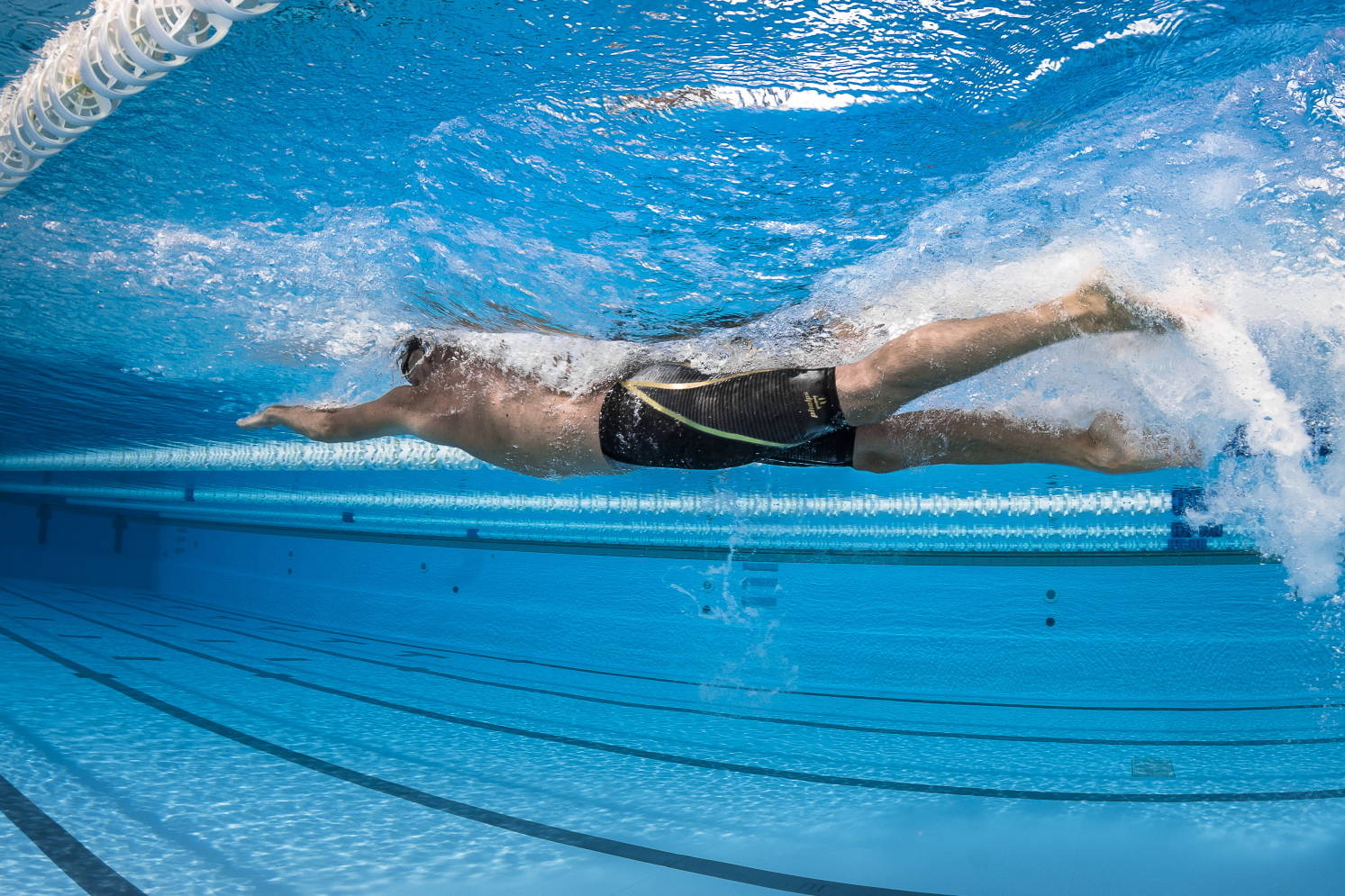Beim Schwimmen im Triathlonwettkampf spielen die Beine eine untergeordnete Rolle. Warum also den Beinschlag trainieren? Wir erklären euch, warum der zumeist ungeliebte Trainingsinhalt einen großen Anteil am Schwimmerfolg haben sollte.
Wenn man sich mit Triathleten zum Thema Schwimmtraining unterhält, bekommt man oft Sätze wie „Beine mach ich gar nicht. Ich heb mir die Kraft fürs Radfahren auf“ oder „Mein Neo zieht mir die Beine eh nach oben“ zu hören. Diese Argumentation scheinen fürs erste logisch und viele Hobbyathleten lassen deshalb das Beinschlagtraining komplett außen vor. Doch gerade Langdistanzprofis widmen dem Beinschlagtraining einen beachtlichen Teil ihrer Schwimmeinheiten, es muss also Vorteile mit sich bringen, eine gute Beinarbeit zu haben.
Stabiler Schwimmen
Wer einen gleichmäßigen Beinschlag schwimmen kann, liegt viel stabiler im Wasser und kann die wasserwiderstandsarme Stromlinienform besser halten. Die Beinarbeit vermeidet seitliche Ausweichbewegungen der Hüfte und fördert eine gerade und gestreckte Haltung. Außerdem leiten die Beine die leichte Rollbewegung des Körpers um die Körperlängsachse ein. Wer seine Beine also nur passiv hinterher zieht, verliert hier wesentliche Vorteile des effektiven Gleitens.
Neoprenverbot: was nun?
Stichwort Neoprenverbot: ist die Wassertemperatur zu hoch, wird der Neoprenanzug als Kälteschutzanzug verboten. Viele Athleten verlassen sich jedoch allzu sehr auf die nützlichen Auftriebseigenschaften des Neoprenanzugs und stehen dann vor einer deutlich größeren Herausforderung im Wettkampf - auch eine mentale Hürde.
Da es für die meisten Langstreckenkrauler beim Beinschlag weniger um Vortrieb als um die Stabilisierung der Wasserlage geht, sollten die Bewegungen nicht allzu schnell, dafür aber umso gleichmäßiger durchgeführt werden, damit wir noch fit fürs anschließende Radfahren und Laufen sind.
Wer sich überzeugen möchte, wie wichtig der Beinschlag ist, schwimmt einfach mal 100 Meter Kraul mit überkeuzten Beinen. Es gibt also genügend Gründe, mit Beinschlag zu schwimmen und ihn entsprechend zu trainieren. Wie ihr das am besten machen könnt, zeigen wir euch im nächsten Abschnitt.
Schalte den Turbo ein
Den Klassiker „Beinschlag in Bauchlage mit oder ohne Brett“ kennt jeder. Ein wenig Abwechslung kann aber nicht schaden. Eine beliebte Alternative ist der Beinschlag in Seitlage, der Blick geht also an den Beckenrand oder auf die Nachbarbahn. Die Arme befinden sich in der so genannten „Superman-Position“, das heißt der Arm der untenliegenden Seite wird nach vorne gestreckt und liegt unter dem Kopf, die obere Hand liegt auf der Hüfte. Zum Atmen wird der Kopf einfach nach oben gedreht.
Um ein wenig Abwechslung zu schaffen, könnt ihr einen Teil des Beinschlagtrainings auch mit Delphin – oder Brustbeinschlag oder in Rückenlage durchführen. Ihr trainiert dadurch eure Beinmuskulatur vielseitiger. Bei allen Übungen könnt ihr ein wenig mit der Amplitude und Frequenz des Beinschlags und der Lage der Beine im Wasser spielen. Für jeden Athleten gibt es eine individuelle optimale Position.
Blick zu den Profis kann nicht schaden
Ihr könnt die Übung natürlich mit Kraulbeinschlag durchführen. Leichte Wischbewegungen mit den Händen erleichtern die Aufgabe zusätzlich. Zwei Serien mit 3 bis 4 mal 10 Sekunden reichen für den Anfang. Wer schon etwas fortgeschrittener ist, legt die Arme an der Hüfte an, oder hält sie sogar aus dem Wasser.
Übrigens: Michael Phelps hat außerdem noch einen Gewichtsgürtel um die Hüfte!
Stellt sich noch die Frage: mit oder ohne Flossen?
Flossen verlängern den Fuß, dadurch wird der Beinschlag effizienter und ihr habt einen besseren Vortrieb. Wer Probleme mit der Beweglichkeit im Fußgelenk hat, kann das neben speziellen Dehnübungen auch mit Flossen korrigieren. Durch den höheren Wasserwiderstand wird euer Fuß stärker gestreckt als beim normalen Schwimmen. Und natürlich trainiert ihr beim Flossenschwimmen auch die Beinkraft.
Obwohl es viele Vorteile hat, solltet ihr das Training mit dem geliebten Hilfsmittel nicht übertreiben, vor allem Anfänger müssen ihrer Muskulatur die nötige Zeit zur Anpassung geben. Überlastungserscheinungen an Sehnen und Bändern, vor allem im Fußgelenk, sind die Folge von zu langem und intensivem Flossentraining. Auch Krämpfe in Fuß und Wade können auftreten.
Die richtigen Flossen minimieren das Verletzungsrisiko und verhindern, dass ihr eure Technik kaputt macht. Die Rede ist von Kurzflossen. Sie lassen im Vergleich zu Taucherflossen eine normale Beinschlagfrequenz zu.
Fazit: Beinschlagtraining mit Flossen unbedingt, aber nicht übertreiben
Wer in der Vorbereitung den Beinschlag konsequent in sein Training einbaut, wird in der kommenden Saison deutlich ruhiger und effizienter durch das Wasser gleiten, auch oder gerade auch dann, wenn der geliebte Neoprenanzug wegen zu hoher Wassertemperatur verboten wird.
Zugehörige Kategorien





















3 Kommentare
Christoph
Wollte euch mal ein Lob da lassen. Ihr macht tolle Artikel und super interessanten Content.
Auch die Triathlon Veranstaltungen sind super organisiert. Weiter so, und herzliche Grüße
triathlon.de Redaktion
Lieber Hansjörg,
der Hinweis “Arme aus dem Wasser” bezieht sich auf verschiedene Positionen, in denen Du den Kraulbeinschlag ausführen kannst, z.B. stehend im tieferen Wasser oder in Seitlage. Wenn Du dort den Arm bzw. die Arme nach oben streckst, wird die Übung deutlich anspruchsvoller. Deine triathlon.de Redaktion
Hansjörg Willems
Aus dem nachfolgenden Beitrag stellt sich mir, wie ich beim Kraulbeinschlag die Arme aus dem Wasser halten soll?
“Ihr könnt die Übung natürlich mit Kraulbeinschlag durchführen. Leichte Wischbewegungen mit den Händen erleichtern die Aufgabe zusätzlich. Zwei Serien mit 3 bis 4 mal 10 Sekunden reichen für den Anfang. Wer schon etwas fortgeschrittener ist, legt die Arme an der Hüfte an, oder hält sie sogar aus dem Wasser.”